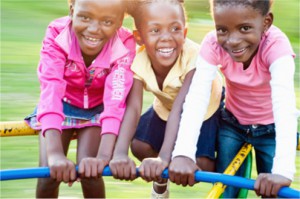Children’s Activities: Get Kids Moving
Keep children moving while learning with daily, quick and creative physical activities. Ideally, kids should have two to three active play times every day. Instead of thinking of exercise as a separate scheduled activity, just try to weave quick “moving” moments throughout the day.
1,2,3,4: Hip, Hop, Move: Use this Caribbean-inspired dance to help young children count to four.
5 W’s: Who? What? Where? When? Why? This activity incorporates reading comprehension with movement.
Adapting the Child Care Environment for Children with Special Needs: When working with special needs children, it is important to focus on each child’s strength as you work to make adjustments. Many modifications can be simple ones. This article covers making adaptations, general accommodations, and additional resources for specific disabilities.
Back to Sleep, Tummy to Play: This article emphasizes that while tummy time is important, babies are safest on their backs while sleeping. Learn more about how to engage infants during tummy time.
Be Active Kids: Be Active Kids is an innovative, interactive health program for children ages birth to five. It is available to adults working in child care centers, child care homes, and schools. Available resources include handouts with ideas for active play with free or low cost equipment.
Color Me Healthy Sing & Dance: Color Me Healthy music gets children up and moving to a fun and happy beat. Download songs (MP3 format) and lyrics (PDFs) and dance to the tune of Color Me Healthy. The Color Me Healthy program also includes a teacher’s guide with 12 circle time lessons (including picture cards), parent newsletters (in English and Spanish) and five colorful posters.
Dance Activity: This activity gets kids dancing in silly ways — sometimes moving just their knees, thumbs or elbows.
Early Childhood Resources: SHAPE America early childhood resources teach the importance of physical activity for young children. They offer a variety of activity ideas, strategies, information and guidelines to use the space and materials you have, and how to model and encourage healthy habits and physical activity.
Fitness and Toddlers (KidsHealth): Kids this age are walking and running, kicking, and throwing. They’re naturally active, so be sure to provide lots of chances for children to practice and build on these skills.
Get Moving Today Calendar: A start-anytime, reusable calendar from Head Start Body Start which has fun, simple physical activities to do everyday with preschoolers.
GoNoodle: GoNoodle helps teachers and parents get kids moving with short interactive activities. Any teacher, anywhere, can create a free GoNoodle account and start using movement activities right away.Using exercise science and cutting-edge research, GoNoodle has designed all of activities to be healthy for the body, engaging for the attention, and beneficial to the brain in specific ways. The website allows users to filer by age group for PreK users.
Head to Toe, Letter ‘O’: Fun rhymes and movements teach young children about healthy foods.
Healthy Habits for Life: Get Moving: The Healthy Habits for Life Child Care Resource Kit gives you the tools you need to teach children about eating right and being physically active so that they can establish healthy habits for life. This section offers easy and fun ideas and activities to get kids moving.
Let’s Get Ready to Learn: Capture preschoolers’ attention and get them moving at the start of the day with this chant.
Non-Competitive Active Games for Preschoolers: A job aid from Child Care Aware® of America (formerly NACCRRA) which includes tips for making some traditional games non-competitive.
Preschooler Activity Calendar (Alberta Health Services): This calendar has ideas for children from 3 to 5 years old and has been created to provide an activity to try with your children every day. These activities do not require a lot of time, materials or preparation so you can fit them into your daily routine.
Rainy Day Physical Activities for Toddlers and Preschoolers (National Food Service Management Institute and The University of Mississippi): What to do when outdoor play is unavailable? This resource provides a variety of indoor physical activities to get children moving and having fun—from very simple play for toddlers and infants, to more challenging activities for preschoolers.
Safe Exploring for Preschoolers (KidsHealth): Kids ages 3-5 have tons of energy and are eager to walk, run, dance, and play. It’s a great age for exploration too. Preschoolers learn a lot when given the chance to investigate their environments (with supervision, of course). They can focus their energy and tackle more complex activities like playing dress-up, riding trikes, or planting seeds.
We Have the Moves: This resource from Sesame Street provides fun physical activities for both large and small spaces that require minimal time and equipment. Discover easy ways to add more active play into everyday routines for children ages 2-5.


